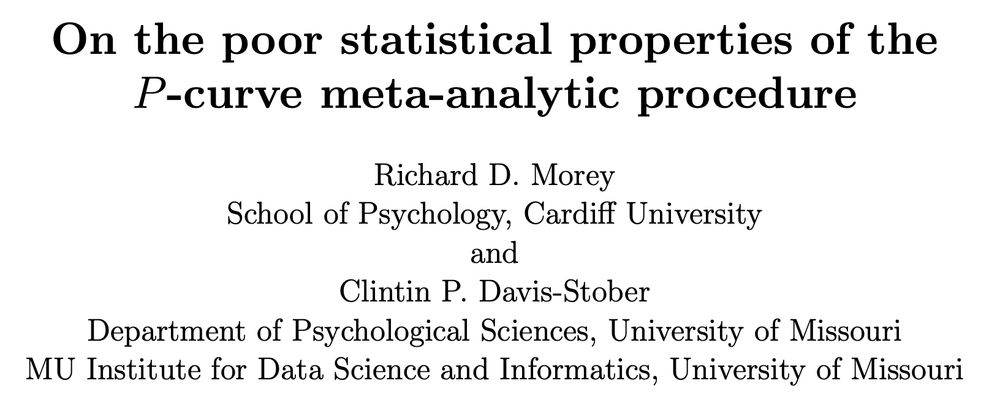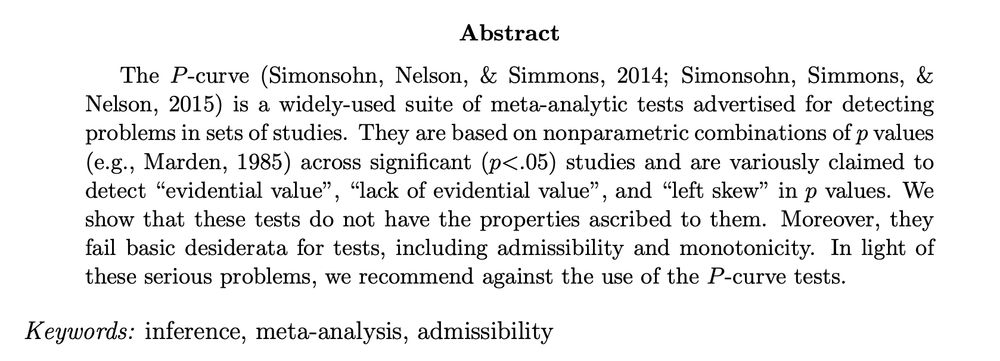
Make an effect size prediction!
@jamiecummins.bsky.social and I are replicating Balcetis & Dunning's (2010) "chocolate is more desirable than poop" (Cohen's d = 4.52)
Let us known in the replies what effect size you think we'll find. Details of the study in the thread below.
13.10.2025 11:30 — 👍 60 🔁 22 💬 17 📌 7
note that in the ggplot2 the default pointsize is not a constant anymore
GeomPoint$default_aes
#> Aesthetic mapping:
#> * `shape` -> `from_theme(pointshape)`
#> * `colour` -> `from_theme(colour %||% ink)`
#> * `fill` -> `from_theme(fill %||% NA)`
#> * `size` -> `from_theme(pointsize)`
09.10.2025 20:24 — 👍 2 🔁 2 💬 1 📌 0

Bayes Club
A community of statisticians using Bayesian methods.
If you feel so inclined, I run a Mastodon instance bayes.club and try to make it a nice place and you can join if you like. I know some people have strong opinions on this and some have had bad experience on Mastodon. And that's all fair and I won't dispute that, there's a lot of work to do.
07.10.2025 14:43 — 👍 5 🔁 2 💬 0 📌 0

ELLIS PhD Program: Call for Applications 2025
The ELLIS mission is to create a diverse European network that promotes research excellence and advances breakthroughs in AI, as well as a pan-European PhD program to educate the next generation of AI...
I'm looking for a doctoral student with Bayesian background to work on Bayesian workflow and cross-validation (see my publication list users.aalto.fi/~ave/publica... for my recent work) at Aalto University.
Apply through the ELLIS PhD program (dl October 31) ellis.eu/news/ellis-p...
06.10.2025 09:28 — 👍 45 🔁 34 💬 0 📌 1
Nobody:
Line plots: These are her mountains and skies and she radiates
Through history's rivers of blood, she regenerates
26.09.2025 06:48 — 👍 1 🔁 0 💬 0 📌 0
One thing I find so strange about the P-curve is how once it was published, the burden of proof shifted to others to prove that it is bad (in ways that Simonsohn would care about, at least), rather than the authors, to prove that it works in general (for standard definitions of "works"). (21/x)
25.09.2025 10:07 — 👍 16 🔁 4 💬 1 📌 2
Simonsohn has now posted a blog response to our recent paper about the poor statistical properties of the P curve. @clintin.bsky.social and I are finishing up a less-technical paper that will serve as a response. But I wanted to address a meta-issue *around* this that may clarify some things. 1/x
25.09.2025 10:07 — 👍 72 🔁 29 💬 2 📌 6

Retraction Note: High replicability of newly discovered social-behavioural findings is achievable - Nature Human Behaviour
Nature Human Behaviour - Retraction Note: High replicability of newly discovered social-behavioural findings is achievable
It's officially been a year since this paper was retracted. In the wake, the authors claimed (misleadingly) it was just a couple pesky sentences... a revise and resubmit.
Since then, radio silence with not even an update to the preprint.
www.nature.com/articles/s41...
24.09.2025 12:11 — 👍 20 🔁 4 💬 2 📌 0
Fewer people hit/spank/beat their kids and it is less socially acceptable to do so.
15.09.2025 11:27 — 👍 0 🔁 0 💬 0 📌 0
this might be a bit of a long shot, but is anyone here willing to share documents of an ERC (starting) grant? or any insights into the process, things you wished you knew before…? i would be very thankful as i think it is quite different from programs i am familiar with so far. ☀️
08.09.2025 13:38 — 👍 17 🔁 7 💬 2 📌 0
But apparently most of the Internet agrees that "population" estimates are "preferred for RCTs" but without any explanation why! Have I lost my mind? Or is this one of the situation where "we have always done things this way"? 3/3
03.09.2025 13:05 — 👍 2 🔁 0 💬 0 📌 0
they worry that for one outcome GLMMs provide "subject-specific" estimate and we should consider GEE to get "population" estimate. This seems weird to me, because the sites are a convenience sample and I really want to generalize to other sites and make decisions for individual patients 2/3
03.09.2025 13:05 — 👍 2 🔁 0 💬 1 📌 0
I am **NOW** writing a response to regulator on a first RCT I helped design and the plan is to use random intercepts for sites, so I ponder as well. The regulator doesn't mind the random effects (we plan fixed ef as sensitivity analysis), but, on a related note, 1/3
03.09.2025 13:05 — 👍 2 🔁 0 💬 1 📌 0
*cracks knuckles*
okay so you know how the media has a problem with taking snippets of scientific studies out of context and writing articles which mislead the public?
now imagine a computer program is doing that when you ask it questions about scientific literature but also it makes stuff up.
02.09.2025 20:41 — 👍 4145 🔁 744 💬 80 📌 29

Release of CmdStan 2.37
We are very happy to announce that the 2.37.0 release of CmdStan is now available on Github! As usual, the release of CmdStan is accompanied by new releases of Stan Math, core Stan, and Stanc3. Thi…
Stan / CmdStan 2.37 release!
blog.mc-stan.org/2025/09/02/r...
- sum_to_zero_matrix type sums to zero across both rows and columns
- simplex and *_stochastic_matrix types should be now faster and more stable
- new functions exposing the built-in constraint implementations
1/2
02.09.2025 17:06 — 👍 21 🔁 9 💬 1 📌 0
A SQL query goes into a bar, walks up to 2 tables and says “Can I join you?”
03.09.2025 02:37 — 👍 22 🔁 4 💬 0 📌 0

Citogenesis
Obligatory: xkcd.com/978/
The LLM use could however increase efficiency of the process substantially
02.09.2025 05:59 — 👍 0 🔁 0 💬 0 📌 0

Destroy this myth. Please share if you have visited and researched in a library this past year! RT And give a shout out to your favorite library you have ever visited.
21.12.2024 00:49 — 👍 22051 🔁 8744 💬 1062 📌 1056

One Epidemic, Many Estimates (1EME)
One Epidemic, Many Estimates (1EME)
📢 Interested in excess mortality methods, and want a challenge? I'm organising the "One Epidemic, Many Estimates" (1EME) project! Register *now* as a many analyst team (submissions due 15 March 2026), and then join us at LSE for a workshop on 21-22 May 2026! (1/n)
www.lse.ac.uk/Economic-His...
27.08.2025 08:54 — 👍 64 🔁 47 💬 3 📌 10
Great to see this happen and a good opportunity to caution against some pitfalls in many-analyst studies: www.pnas.org/doi/10.1073/...
Can't imagine a better team to pull this off, so do join
27.08.2025 15:28 — 👍 12 🔁 3 💬 1 📌 0

Models as Prediction Machines: How to Convert Confusing Coefficients into Clear Quantities
Abstract
Psychological researchers usually make sense of regression models by interpreting coefficient estimates directly. This works well enough for simple linear models, but is more challenging for more complex models with, for example, categorical variables, interactions, non-linearities, and hierarchical structures. Here, we introduce an alternative approach to making sense of statistical models. The central idea is to abstract away from the mechanics of estimation, and to treat models as “counterfactual prediction machines,” which are subsequently queried to estimate quantities and conduct tests that matter substantively. This workflow is model-agnostic; it can be applied in a consistent fashion to draw causal or descriptive inference from a wide range of models. We illustrate how to implement this workflow with the marginaleffects package, which supports over 100 different classes of models in R and Python, and present two worked examples. These examples show how the workflow can be applied across designs (e.g., observational study, randomized experiment) to answer different research questions (e.g., associations, causal effects, effect heterogeneity) while facing various challenges (e.g., controlling for confounders in a flexible manner, modelling ordinal outcomes, and interpreting non-linear models).

Figure illustrating model predictions. On the X-axis the predictor, annual gross income in Euro. On the Y-axis the outcome, predicted life satisfaction. A solid line marks the curve of predictions on which individual data points are marked as model-implied outcomes at incomes of interest. Comparing two such predictions gives us a comparison. We can also fit a tangent to the line of predictions, which illustrates the slope at any given point of the curve.

A figure illustrating various ways to include age as a predictor in a model. On the x-axis age (predictor), on the y-axis the outcome (model-implied importance of friends, including confidence intervals).
Illustrated are
1. age as a categorical predictor, resultings in the predictions bouncing around a lot with wide confidence intervals
2. age as a linear predictor, which forces a straight line through the data points that has a very tight confidence band and
3. age splines, which lies somewhere in between as it smoothly follows the data but has more uncertainty than the straight line.
Ever stared at a table of regression coefficients & wondered what you're doing with your life?
Very excited to share this gentle introduction to another way of making sense of statistical models (w @vincentab.bsky.social)
Preprint: doi.org/10.31234/osf...
Website: j-rohrer.github.io/marginal-psy...
25.08.2025 11:49 — 👍 946 🔁 284 💬 48 📌 19
+1 I rarely get much stuff done when caring for the kids, except when the dishwasher needs unloading :-D
10.08.2025 17:28 — 👍 4 🔁 0 💬 1 📌 0
New paper with @richarddmorey.bsky.social now out in JASA, where we critically examine p-curve. Below is Richard’s excellent summary of the many poor statistical properties of p-curve (with link to paper). I wanted to add some conceptual issues that we also tackle in the paper.
09.08.2025 21:18 — 👍 52 🔁 20 💬 2 📌 2

Cover page for the manuscript: Morey, R. D., & Davis-Stober, C. P. (2025). On the poor statistical properties of the P-curve meta-analytic procedure. Journal of the American Statistical Association, 1–19. https://doi.org/10.1080/01621459.2025.2544397

Abstract for the paper: The P-curve (Simonsohn, Nelson, & Simmons, 2014; Simonsohn, Simmons, & Nelson, 2015) is a widely-used suite of meta-analytic tests advertised for detecting problems in sets of studies. They are based on nonparametric combinations of p values (e.g., Marden, 1985) across significant (p < .05) studies and are variously claimed to detect “evidential value”, “lack of evidential value”, and “left skew” in p values. We show that these tests do not have the properties ascribed to them. Moreover, they fail basic desiderata for tests, including admissibility and monotonicity. In light of these serious problems, we recommend against the use of the P-curve tests.
Paper drop, for anyone interested in #metascience, #statistics, or #metaanalysis! @clintin.bsky.social and I show in a new paper in JASA that the P-curve, a popular forensic meta-analysis method, has deeply undesirable statistical properties. www.tandfonline.com/doi/full/10.... 1/?
08.08.2025 18:55 — 👍 288 🔁 122 💬 17 📌 26
this is really good -- completely aligns with where ive come to myself on this after much difficulty and costly error
03.08.2025 09:08 — 👍 30 🔁 2 💬 3 📌 0
My experience also supports that. The workout/exercise stuff was explained to a hopeless ~22yo me by a friend and he was right: the effects of workout on your mental state and relationship to your body are both more important and easier to achieve than any noticeable change in your appearance.
03.08.2025 18:49 — 👍 1 🔁 0 💬 0 📌 0
So I think there is a niche of things like tool benchmarks where what you want to do is empirics in silico and this type of prereg can make sense. Though I agree that in a fashion typical to COS they assume a single type of simulation study they are familiar with is the only possible type..
30.07.2025 19:24 — 👍 1 🔁 0 💬 1 📌 0
And already at the time there was a long history of unfulfilled claims that the next game revolution will be in AI. Turns out that "smart" or "optimal" and "fun to play" only very rarely align. "smart" often meant hard to debug, hard to tweak to match design goals and expensive computation 2/2
29.07.2025 09:28 — 👍 4 🔁 0 💬 1 📌 0
It's just terminology: when I was involved in game AI (2010s), ~90% of industry-oriented articles self-described as AI were on navigation, finite state machines and behavior trees (kinda like decision trees). Making something that's fun to play with/against and eats little CPU is hard! 1/2
29.07.2025 09:28 — 👍 4 🔁 0 💬 1 📌 0
allegedly, a researcher in bayesian stats
(toolmaker is probably more accurate)
lunafazio.github.io
Assistant Professor, Statistical Sciences + School of the Environment at the University of Toronto. Bayesian ecological + environmental stats. Bilingüe. ✡️🌈
https://www.vleosbarajas.com
Assistant Prof in ML @ KTH 🇸🇪.
Previous: Aalto University 🇫🇮, TU Graz 🇦🇹, originally from 🇩🇪.
Doing: Reliable ML | uncertainty stuff | Bayesian stats | probabilistic circuits
https://trappmartin.github.io/
Assoc Prof Computer Science and Communication Studies at Northwestern. Infovis, HCI. Author of tidybayes & ggdist R pkgs. he/him. 🏳️🌈 https://mjskay.com/
Co-director https://mucollective.northwestern.edu
Co-founder https://journalovi.org
philosopher at the university of washington. ⚧
in the northern deep is a fish; its name is roe . . .
。zZ }Ĭ{
ERROR is a bug bounty program for science
https://error.reviews/
PIs: @malte.the100.ci & @ruben.the100.ci
Chief Recommender: @ianhussey.bsky.social
Recommender: @jamiecummins.bsky.social
Paid to do
p(b | a) p(a)
p(a | b) = —————————
p(b)
Data Scientist | Computational Psychologist | Devout Bayesian
https://bayesianbeginnings.com/
Senior Fellow, Carnegie Endowment. Defense analysis with a focus on the Russian and Ukrainian militaries.
data scientist studying how kids learn to speak, dad, jump roper, bayesian, tjmahr.com
Associate Professor of Biostatistics at Emory Rollins School of Public Health
Professor of Medical Statistics @qmul.ac.uk. I study how to design evaluations of health technologies and health service interventions. Sometimes I just make patterns.
Stepped Wedgehog (you won't be surprised to hear) posts on stepped wedge trials and related topics. Visit the website at https://steppedwedgehog.org.
Professor of #CogSci and #Stats @UCIrvine; Pursuer of Lofty Undertakings; Purveyor of Articles Odd and Quaint; and Protector of the Realm. #blm #trahr he/him
I’m not like the other Bayesians. I’m different.
Thinks about philosophy of science, AI ethics, machine learning, models, & metascience. postdoc @ Princeton.
AI in Bio & Health & Therapeutic Development
Bio: https://linktr.ee/mnarayan
Substack: https://blog.neurostats.org
Peek into my brain: notes.manjarinarayan.org
Previously @dynotx @StanfordMed PhD@RiceU_ECE | BS@ECEILLINOIS
🧪🧮⚕️🧬🧠🖥🤖📈✍️🩺👩📈📉
https://olivia.science
assistant professor of computational cognitive science · she/they · cypriot/kıbrıslı/κυπραία · σὺν Ἀθηνᾷ καὶ χεῖρα κίνει
Cognitive Science at Aarhus Uni. Curious about social interactions, symbolic behaviors, and meta-science. Focus on stats, computational modeling, machine learning, complex systems, language, exp semiotics and neuropsychiatric conditions. He/They.
econ, epi, stats, meta, causal inference mutant scientist, epistemic humility fairy godmother, chaos muppet.
doing researchy metasciencey stuff at the Center for Open Science
A philosopher of science, among other things.
University of Helsinki
https://www.inkerikoskinen.net
Faculty at UC San Diego. Chief Health AI Officer at UC San Diego Health. #rstats. Creator of Tidier.jl #julialang. #GoBlue. Views own.














